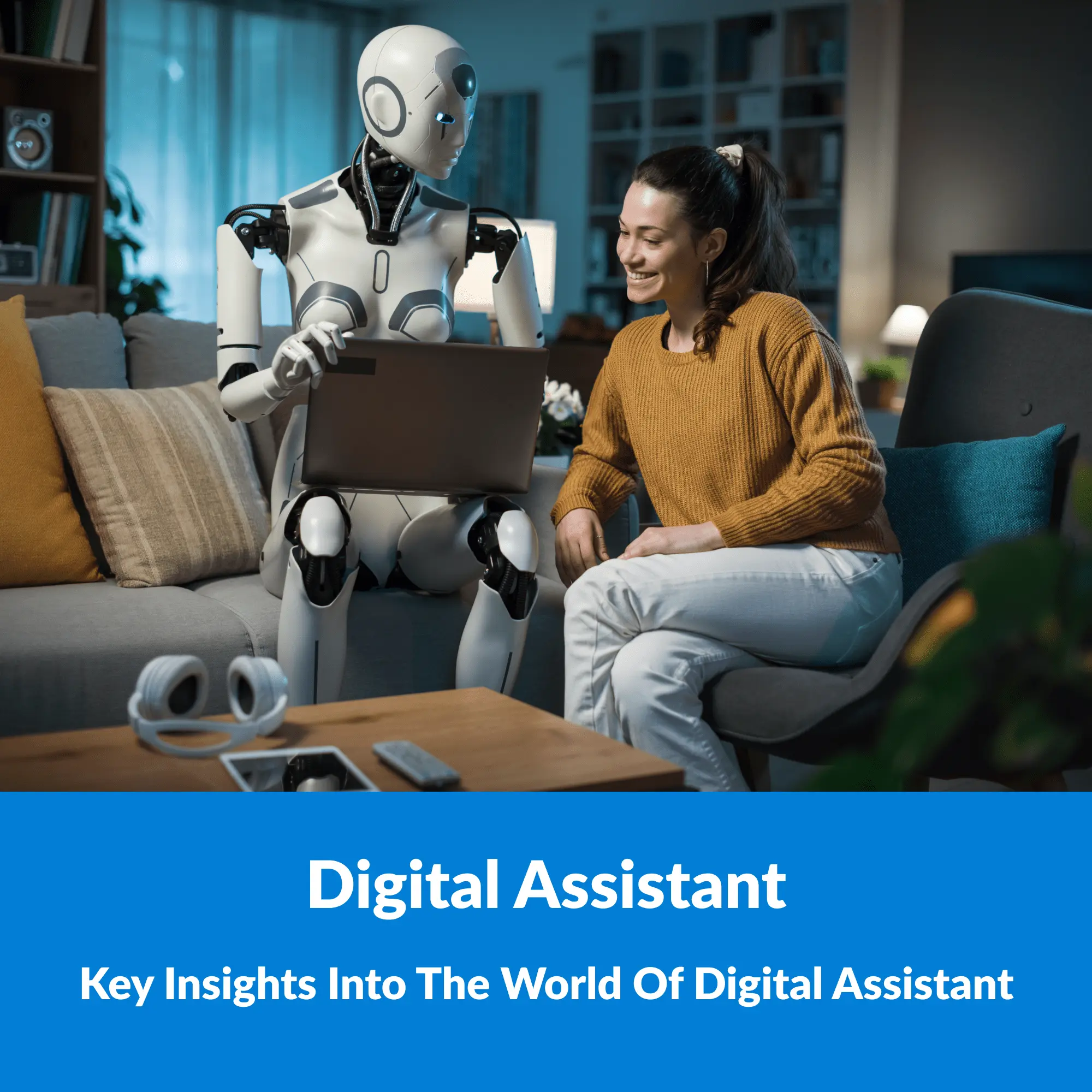Picture this: your morning chaos. Coffee spills, missed alarms, and the frantic search for keys. Enter your digital assistant, calmly suggesting a soothing morning playlist, adjusting the thermostat, and even reminding you of that crucial meeting. This isn’t the future – it’s reality. These intelligent companions have swiftly integrated into our daily lives, aiding us in various tasks and simplifying complex processes. In this article, we delve into the world of digital assistants, exploring what they are, what they can do, how they work, their benefits, the different types available.
Preface: This article diverges from our usual focus on Epilogue Opus, our digital adoption platform. We occasionally like to explore diverse subjects to provide interesting insights and perspectives. We appreciate your readership.
What is a Digital Assistant?
A digital assistant is much more than a tool that responds to voice commands or types out calendar reminders. This advanced computer program simulates a conversation with the people who use it, typically over the internet. It’s a sophisticated blend of technology and user experience, designed to make life simpler, more efficient, and more connected.
By analyzing a wealth of historical data, including factors like purchase habits, location, home ownership, family size and more, they develop data models that detect and adapt to behavioral patterns. As they accumulate data, their understanding and predictive capabilities enhance. In the other words, digital assistants are constantly learning and evolving, becoming more intuitive and responsive with each interaction.
So what can a Digital Assistant do? 12 key features
Digital assistants, with their advanced technology and wide range of capabilities, have become invaluable tools in both personal and professional settings. Here’s a more detailed look at their key features:
1. Interactive Communication:
They use voice or text-based interaction, allowing users to perform tasks hands-free or through simple messaging. This feature is particularly useful for multitasking or when manual interaction is inconvenient.
2. Smart Integration:
Digital assistants can seamlessly integrate with various software and applications. This integration enables them to manage emails, set reminders, control smart home devices, or even assist in business operations like scheduling meetings and managing workflows.
3. Personalization:
They adapt to individual user preferences and histories, offering personalized suggestions and experiences. This could range from recommending music based on past listening habits to providing custom news briefings or travel suggestions.
4. Routine Automation:
One of the most significant advantages is the automation of repetitive tasks. This includes setting alarms, managing to-do lists, automating email responses, or even controlling home automation systems.
5. Real-Time Information Access:
Digital assistants provide instant access to a plethora of information such as weather updates, traffic conditions, latest news, stock market trends, or even educational content.
6. Learning and Adaptation:
Through machine learning and AI, these assistants continuously learn from user interactions, improving their accuracy and relevance in responses and suggestions over time.
7. Support and Accessibility:
They offer support for differently-abled individuals, like voice commands for visually impaired users or text-based interaction for those with hearing impairments. This enhances accessibility and ease of use.
8. Language Translation and Multilingual Support:
Many digital assistants are equipped with real-time translation capabilities and support multiple languages, breaking down language barriers and facilitating international communication.
9. Guided Assistance in Applications:
In complex software environments, digital assistants can guide users through processes, helping them to navigate and use applications more effectively. This is especially useful in professional settings where software complexity can be a barrier to productivity.
10. Data Analysis and Reporting:
In a business context, digital assistants can analyze data, generate reports, and provide insights, aiding in decision-making and strategic planning.
11. Shopping and Transaction Assistance:
They can assist in online shopping, from product searches to transaction processes, making online purchasing more convenient and efficient.
12. Entertainment and Leisure:
Digital assistants can play music, audiobooks, podcasts, or even interact in a conversational manner for entertainment purposes.
How Does a Digital Assistant Work?
Understanding the inner workings of digital assistants reveals the complexity and sophistication behind their seemingly effortless operations. Here’s an expanded look at the key technologies and processes involved:
– Natural Language Processing (NLP): At the heart of every digital assistant is NLP, a branch of artificial intelligence that enables the understanding, interpretation, and generation of human language. NLP algorithms analyze the user’s input, whether spoken or typed, deciphering intent and meaning. This process involves complex tasks like speech recognition, syntax analysis, semantic analysis, and context understanding.
– Machine Learning and AI: These assistants continually learn and adapt through machine learning algorithms. They analyze user data, learn patterns, and improve their responses over time. AI enables them to make predictions and provide relevant suggestions based on past interactions, enhancing personalization and accuracy.
– Data Integration and Retrieval: Digital assistants are connected to vast databases and the internet, allowing them to retrieve a wide range of information swiftly. They access weather forecasts, traffic data, news updates, and more, delivering this information in real-time to the user.
– Voice Recognition and Synthesis: Voice-enabled digital assistants utilize advanced voice recognition technology to accurately capture spoken commands and queries. They also employ voice synthesis, converting text into natural-sounding speech, for their responses. This technology is continuously refined for greater accuracy and natural interaction.
– Task Automation and Control: By integrating with other applications and systems, digital assistants can perform tasks on behalf of the user. This includes sending emails, setting reminders, controlling smart home devices, and even executing some aspects of business processes.
– Contextual Awareness: Advanced digital assistants understand the context of queries. They consider the user’s location, time of day, previous interactions, and current activity to provide relevant and personalized responses.
– User Interface (UI) and Experience (UX) Design: A key aspect of their functionality is an intuitive and user-friendly interface. Whether it’s a voice-activated system or a chat interface, the design is crafted to ensure ease of use and accessibility for all users.
– Security and Privacy Protocols: They incorporate robust security measures to protect user data and privacy. This includes encryption, secure data storage, and compliance with privacy regulations to ensure user information is handled responsibly.
– Cloud Computing and Connectivity: Leveraging the power of cloud computing, digital assistants can process large amounts of data quickly and efficiently. This connectivity also enables them to synchronize information across devices and platforms, providing a seamless experience.
– Feedback and Improvement Mechanisms: Finally, they often include mechanisms for user feedback, which is used to refine and improve their functionality, ensuring they remain effective and user-centric.
The Benefits of Today’s Digital Assistants
The evolution of digital assistants has brought forth a multitude of benefits that extend across various facets of daily life and business operations. Here’s a more detailed exploration of these benefits:
– Enhanced Productivity: Digital assistants excel in automating routine tasks allowing users to focus on more complex and creative tasks, thereby boosting overall productivity.
– Personalized User Experience: They use machine learning to adapt to individual preferences and habits, offering a highly personalized experience.
– Accessibility and Inclusivity: Digital assistants provide significant benefits for users with disabilities. Voice commands, for example, aid visually impaired users, while text-based interactions can be a boon for those with hearing difficulties. This inclusivity enhances accessibility for a wider range of users.
– Time-Saving Information Retrieval: They offer quick and efficient access to information, such as news, weather, traffic updates, or educational content.
– Streamlined Communication and Collaboration: In a business context, digital assistants facilitate smoother communication and collaboration. They can coordinate with team members, schedule meetings, send reminders, or even assist in project management tasks.
– Improved Decision Making: With their ability to analyze data and provide insights, digital assistants can aid in better decision-making. This is particularly relevant in business settings where data-driven decisions are crucial.
– Learning and Development Support: Digital assistants can serve as educational tools, offering language learning support, providing answers to academic queries, or ensuring consistent access to policies, practices and procedures.
– Enhanced Customer Service: In customer service, digital assistants can handle inquiries, provide instant support, and even escalate issues as necessary. This leads to faster resolution of customer issues and improved customer satisfaction.
– Cost Efficiency: By automating routine tasks and improving efficiency, digital assistants can lead to cost savings for businesses. Reduced manual effort and increased efficiency translate into lower operational costs.
– Scalability and Flexibility: They offer scalability, catering to the evolving needs of both individuals and businesses. As user requirements grow or change, digital assistants can adapt, offering flexible and scalable solutions.
– Mental Health and Wellness Support: Some digital assistants are designed to provide mental health support, offering mindfulness exercises, stress management tips, or even connecting users with professional help.
– Entertainment and Leisure: They can provide leisure and entertainment options, playing music, reading audiobooks, or engaging in casual conversation, enhancing the quality of leisure time.
10 Types of Digital Assistants
Digital assistants come in various forms, each designed to cater to specific needs and functionalities
1. Chatbots:
Chatbots are the simplest form of digital assistants, primarily used for answering queries and providing customer support. They are programmed with a set of predefined responses and can handle basic interactions, such as answering FAQs or guiding users through website navigation. Chatbots are widely used in customer service to provide instant responses, reducing the need for human intervention.
2. Virtual Assistants:
Virtual assistants like Siri, Alexa, or
Google Assistant represent a more advanced form of digital assistants. They are capable of understanding natural language and performing a wide range of tasks, including setting reminders, providing weather updates, and even controlling smart home devices. These assistants are integrated into smartphones, smart speakers, and various other devices, making them easily accessible for personal use.
3. AI-powered Assistants:
AI-powered assistants take the capabilities of virtual assistants a step further by incorporating advanced artificial intelligence. They can learn from user interactions, adapt their responses, and provide more personalized assistance. These assistants are capable of complex tasks like managing emails, assisting in project management, and even providing recommendations based on user behavior and preferences.
These platforms are specifically designed to facilitate the adoption of digital tools and software within organizations. They provide on-screen guidance, tutorials, and support to help users navigate complex software applications. This type of assistant is particularly useful in corporate environments where employees need to use multiple software tools effectively.
5. Enterprise Assistants:
These are designed for business environments and are tailored to handle enterprise-level tasks. They can integrate with business software, manage large datasets, assist in HR functions, provide business intelligence, and automate workflow processes. Enterprise assistants are instrumental in enhancing productivity and efficiency in the workplace.
6. Specialized Assistants:
These digital assistants are developed for specific industries or tasks. For example, medical assistants that help with patient management, legal assistants for document analysis, or educational assistants that aid in learning and teaching processes. They are tailored to the unique needs of their respective fields.
7. Home Automation Assistants:
These are integrated into smart home systems and are designed to control home devices like lights, thermostats, security systems, and entertainment systems. They enable users to manage their home environment through voice commands or mobile applications, enhancing convenience and comfort.
8. Multilingual Assistants:
Focusing on language versatility, these assistants can understand and interact in multiple languages, making them ideal for multilingual users or for use in international settings.
9. Wearable Device Assistants:
Integrated into wearable technology like smartwatches, these assistants provide on-the-go assistance, health monitoring, and quick access to information, making them ideal for active and health-conscious users.
10. Personal Shopper Assistants:
These assistants specialize in helping users with shopping decisions, providing product recommendations, price comparisons, and even assisting in the purchasing process.
Conclusion:
Digital assistants are no longer relegated to science fiction. They have become our daily companions, streamlining our lives, enhancing our entertainment, and even offering a touch of personalized support. As these AI-powered helpers continue to learn and evolve, the possibilities for digital assistance are truly limitless. So, welcome your digital assistant into your life, and embrace the convenience, efficiency, and personalized experiences it offers as you navigate the ever-evolving digital landscape.










